Life-Cycle Sustainability Assessment of Using Rock Dust as a Partial Replacement of Fine Aggregate and Cement in Concrete Pavements
Abstract
:1. Introduction
2. Materials and Methods
2.1. Characteristics of Rock Dust and Cement
2.2. Concrete Mix Design
2.3. Methodology for Evaluating Alternative Sustainable Strategies
2.4. Feasible Sustainable Strategies with Rock Dust Addition in Concrete
| Strategies | Reference | Sustainable Alternatives | |||||
|---|---|---|---|---|---|---|---|
| A | B | C | D | E | F | G | |
| Concrete mixture | Conventional concrete | 10% rock dust in FA | 20% rock dust in FA | 10% rock dust in FA + 5% in cement | 10% rock dust in FA + 10% in cement | 20% rock dust in FA + 5% in cement | 20% rock dust in FA + 10% in cement |
| Strength [MPa] | 43.5 | 46.5 | 48 | 45 | 43 | 46 | 44 |
| E [GPa] | 34 | 35 | 35 | 34.5 | 34 | 35 | 34 |
| Concrete slab thickness (mm) | 203 | 195 | 190 | 200 | 201 | 200 | 205 |
| Granular base (mm) | 150 | 150 | 150 | 150 | 150 | 150 | 150 |
- = design traffic (18-kip ESALs)
- = standard normal deviate
- = combined standard error for reliability
- = thickness of concrete pavement slab
- = initial and difference between terminal serviceability indices
- = terminal serviceability value
- = modulus of rupture for Portland cement concrete
- = load transfer coefficient
- = drainage coefficient
- = modulus of elasticity for Portland cement concrete
- = modulus of subgrade reaction
| Rigid Pavement Parameters | Values |
|---|---|
| Standard normal deviate, | −1.645 |
| Overall standard deviation, | 0.3 |
| Modulus of rupture, | As per Equation (2) |
| Difference between initial and terminal serviceability indices, | 2.0 |
| Terminal serviceability value, | 2.5 |
| Elastic modulus, | As per Table 1 |
| Modulus of subgrade reaction, k | 5.5 kg/cm3 |
| Load transfer coefficient, | 2.8 |
| Drainage coefficient, | 1.0 |
3. Results and Discussions
3.1. LCCA Results
- NPV = net present value
- = net cash flow at time t
- = discount rate
- = time of cash flow
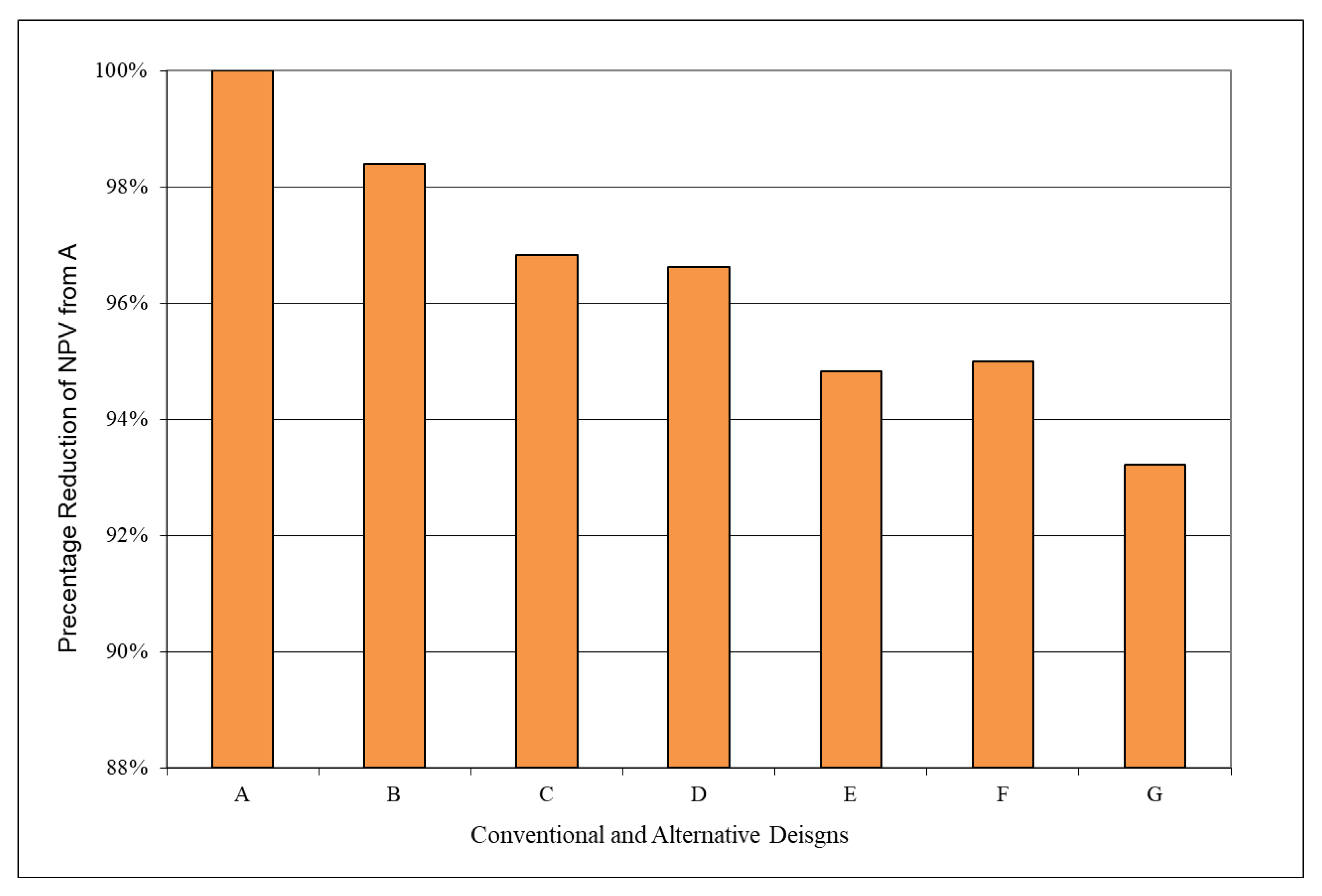
3.2. Life-Cycle Environmental Impacts
4. Sustainability Rating
5. Summary and Conclusions
Author Contributions
Funding
Conflicts of Interest
References
- Nicodème, C.; Diamandouros, K.; Diez, J.; Durso, C.; Arampidou, K.; Nuri, A.K. Road Statistics Yearbook. 2017. Available online: www.erf.be (accessed on 15 August 2022).
- Hoxha, E.; Vignisdottir, H.R.; Barbieri, D.M.; Wang, F.; Bohne, R.A.; Kristensen, T.; Passer, A. Life cycle assessment of roads: Exploring research trends and harmonization challenges. Sci. Total Environ. 2021, 759, 143506. [Google Scholar] [CrossRef] [PubMed]
- Lee, J.; Edil, T.B.; Benson, C.H.; Tinjum, J.M. Building environmentally and economically sustainable transportation infrastructure: Green highway rating system. J. Constr. Eng. Manag. 2013, 139, A4013006. [Google Scholar] [CrossRef]
- Anastasiou, E.K.; Liapis, A.; Papayianni, I. Comparative life cycle assessment of concrete road pavements using industrial by-products as alternative materials. Resour. Conserv. Recycl. 2015, 101, 1–8. [Google Scholar] [CrossRef]
- Harvey, J.; Meijer, J.; Ozer, H.; Al-Qadi, I.L.; Saboori, A.; Kendall, A. Pavement Life Cycle Assessment Framework; No. FHWA-HIF-16-014; Federal Highway Administration: Washington, DC, USA, 2016.
- Zhao, Y.; Goulias, D.; Peterson, D. Recycled Asphalt Pavement materials in transport pavement infrastructure: Sustainability analysis metrics. Sustainability 2021, 13, 8071. [Google Scholar]
- Zhao, Y.; Goulias, D.; Tefa, L.; Bassani, M. Life cycle economic and environmental impacts of CDW recycled aggregates in roadway construction and rehabilitation. Sustainability 2021, 13, 8611. [Google Scholar] [CrossRef]
- Tam, V.W.; Soomro, M.; Evangelista AC, J. A review of recycled aggregate in concrete applications (2000–2017). Constr. Build. Mater. 2018, 172, 272–292. [Google Scholar] [CrossRef]
- Williams, B.A.; Copeland, A.; Ross, T. Asphalt Pavement Industry Survey on Recycled Materials and Warm-Mix Asphalt Usage: 2017; National Asphalt Pavement Association (NAPA): Greenbelt, MD, USA, 2017; FHWA. DTFH61-13-H-00027. [Google Scholar]
- Huang, Y.; Bird, R.N.; Heidrich, O. A review of the use of recycled solid waste materials in asphalt pavements. Resour. Conserv. Recycl. 2007, 52, 58–73. [Google Scholar] [CrossRef]
- Meisuh, B.K.; Kankam, C.K.; Buabin, T.K. Effect of quarry rock dust on the flexural strength of concrete. Case Stud. Constr. Mater. 2018, 8, 16–22. [Google Scholar] [CrossRef]
- Dobiszewska, M.; Bagcal, O.; Beycioğlu, A.; Goulias, D.; Köksal, F.; Niedostatkiewicz, M.; Ürünveren, H. Influence of Rock Dust Additives as Fine Aggregate Replacement on Properties of Cement Composites—A Review. Materials 2022, 15, 2947. [Google Scholar] [CrossRef]
- Dobiszewska, M.; Barnes, R.W. Properties of mortar made with basalt powder as sand replacement. ACI Mater. J. 2020, 117, 3–9. [Google Scholar]
- Ilangovana, R.; Mahendrana, N.; Nagamanib, K. Strength and durability properties of concrete containing quarry rock dust as fine aggregate. ARPN J. Eng. Appl. Sci. 2008, 3, 20–26. [Google Scholar]
- Kou, S.C.; Poon, C.S. Properties of concrete prepared with crushed fine stone, furnace bottom ash and fine recycled aggregate as fine aggregates. Constr. Build. Mater. 2009, 23, 2877–2886. [Google Scholar] [CrossRef]
- Celik, T.; Marar, K. Effects of crushed stone dust on some properties of concrete. Cem. Concr. Res. 1996, 26, 1121–1130. [Google Scholar] [CrossRef]
- Kankam, C.K.; Meisuh, B.K.; Sossou, G.; Buabin, T.K. Stress-strain characteristics of concrete containing quarry rock dust as partial replacement of sand. Case Stud. Constr. Mater. 2017, 7, 66–72. [Google Scholar] [CrossRef]
- Soroka, I.; Setter, N. The effect of fillers on strength of cement mortars. Cem. Concr. Res. 1977, 7, 449–456. [Google Scholar] [CrossRef]
- Del Ponte, K.; Madras Natarajan, B.; Pakes Ahlman, A.; Baker, A.; Elliott, E.; Edil, T.B. Life-Cycle Benefits of Recycled Material in Highway Construction. Transp. Res. Rec. 2017, 2628, 1–11. [Google Scholar] [CrossRef]
- Ding, T.; Xiao, J.; Tam, V.W.Y. A closed-loop life cycle assessment of recycled aggregate concrete utilization in China. Waste Manag. 2016, 56, 367–375. [Google Scholar] [CrossRef]
- Chiu, C.-T.; Hsu, T.-H.; Yang, W.-F. Life cycle assessment on using recycled materials for rehabilitating asphalt pavements. Resour. Conserv. Recycl. 2008, 52, 545–556. [Google Scholar] [CrossRef]
- EN 206 + A1:2016-12; Concrete—Requirements, Properties, Production and Compliance. Polish Committee for Standardization: Warsaw, Poland, 2016.
- EN 12390-3:2019-07; Testing Hardened Concrete—Part 3: Compressive Strength of Test Specimens. European Committee for Standardization: Brussels, Belgium, 2019.
- Gschosser, F.; Wallbaum, H.; Boesch, M.E. Life-cycle assessment of the production of swiss road materials. J. Mater. Civ. Eng. 2012, 24, 168–176. [Google Scholar] [CrossRef]
- AASHTO. AASHTO Guide for Design of Pavement Structures; AASHTO: Washington, DC, USA, 1993; Volume 1. [Google Scholar]
- AASHTO. Mechanical-Empirical Pavement Design Guide, MEPDG, 3rd ed.; AASHTO: Washington, DC, USA, 2020. [Google Scholar]
- Stroup-Gardiner, M. Recycling and Reclamation of Asphalt Pavements Using In-Place Methods; NCHRP Synthesis; The National Academies Press: Washington DC, USA, 2011; p. 421. [Google Scholar]
- Nathman, R.; McNeil, S.; Van Dam, T.J. Integrating environmental perspectives into pavement management: Adding the pavement life-cycle assessment tool for environmental and economic effects to the decision-making toolbox. Transp. Res. Rec. 2009, 2093, 40–49. [Google Scholar] [CrossRef]
- PaLATE. Pavement Life-Cycle Assessment Tool for Environmental and Economic Effects Version 2.0. Consortium on Green Design and Manufacturing, University of California, Berkeley. 2022. Available online: https://rmrc.wisc.edu/palate/ (accessed on 14 May 2022).
- Environmental Protection Agency. US Environmentally—Extended Inpout—Output (USEEIO) Models. 2022. Available online: https://www.epa.gov/land-research/us-environmentally-extended-input-output-useeio-models (accessed on 10 August 2022).
- Carnegie Mellon University. Economic Input-Output Life Cycle Assessment. 2022. Available online: http://www.eiolca.net/ (accessed on 26 July 2022).
- Recycled Materials Resource Centre. Building Environmentally and Economically Sustainable Transportation-Infrastructure-Highways. BE2ST-in-Highways User’s Manual; University of Wisconsin-Madison: Madison, WI, USA, 2012. [Google Scholar]
- Disa, A. Discounting Transport Infrastructure Investments. Swed. Natl. Road Transp. Res. Inst. (VTI) 2018, 2018, 23. [Google Scholar]
- Lawrence, M.; Nguyen, P.; Skolnick, J.; Symoun, J.; Hunt, J.; Alfelor, R. Transportation Systems Management and Operations Benefit-cost Analysis Compendium; No. FHWA-HOP-14-032; Federal Highway Administration: Washington, DC, USA, 2015.
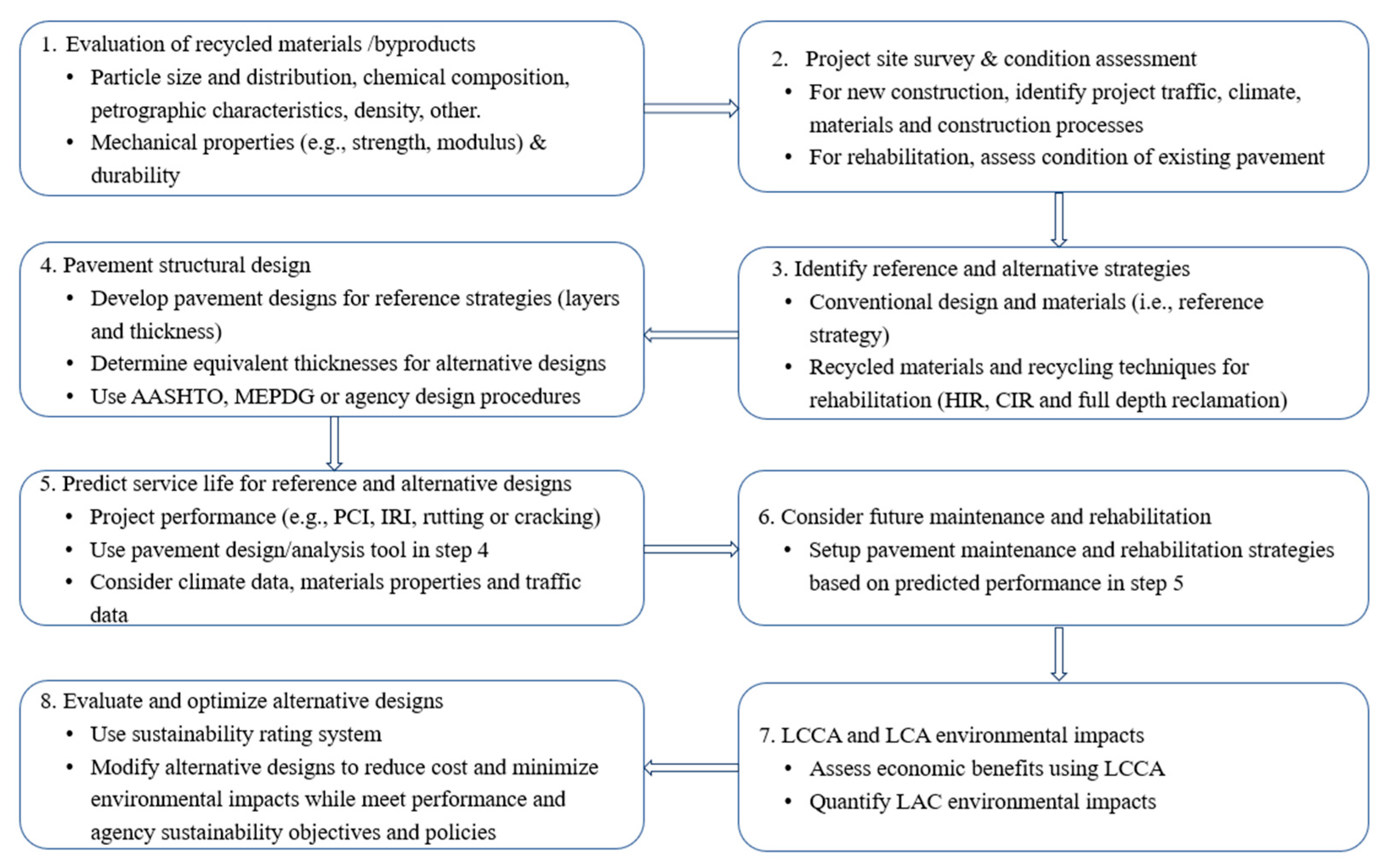
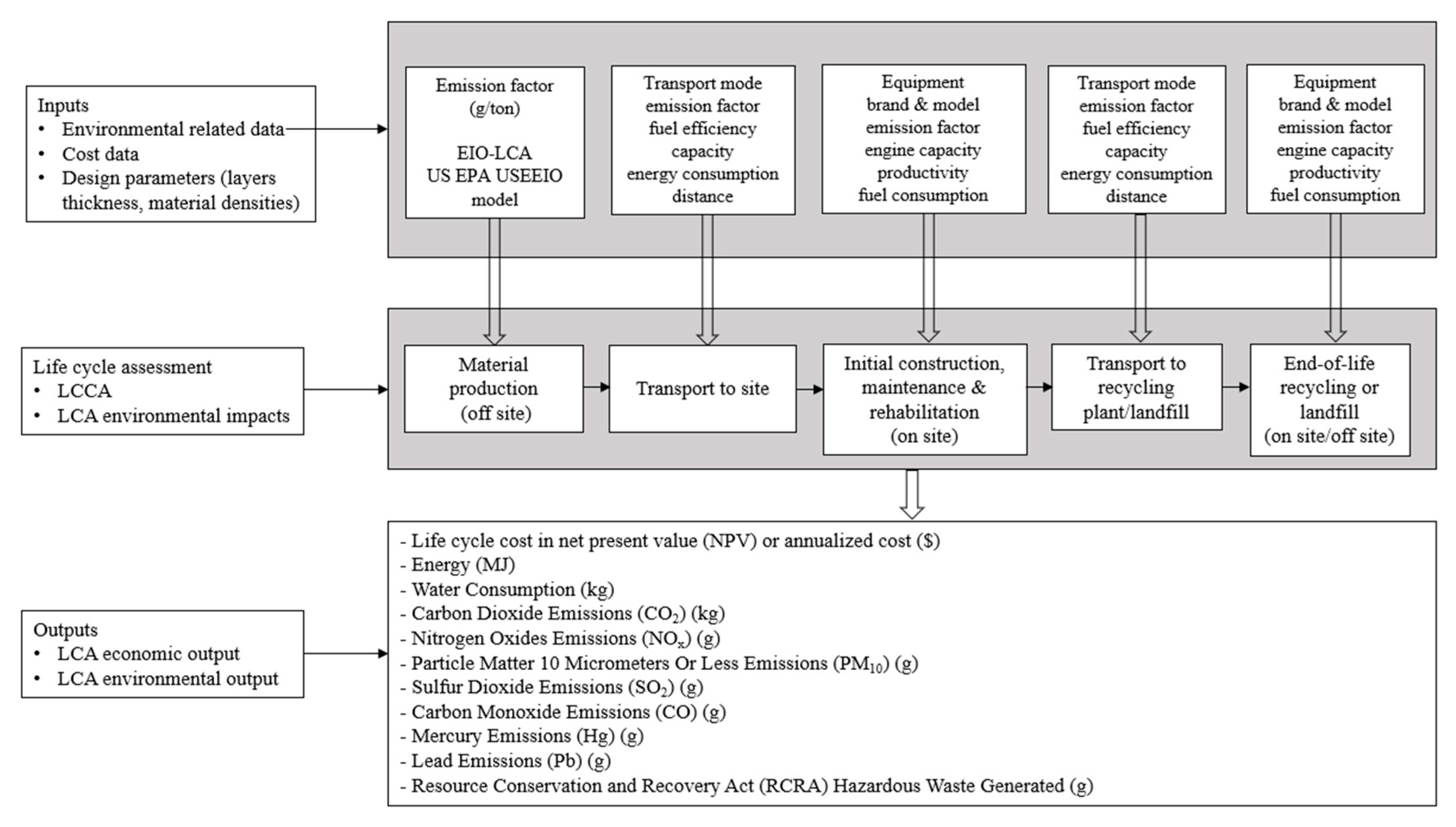
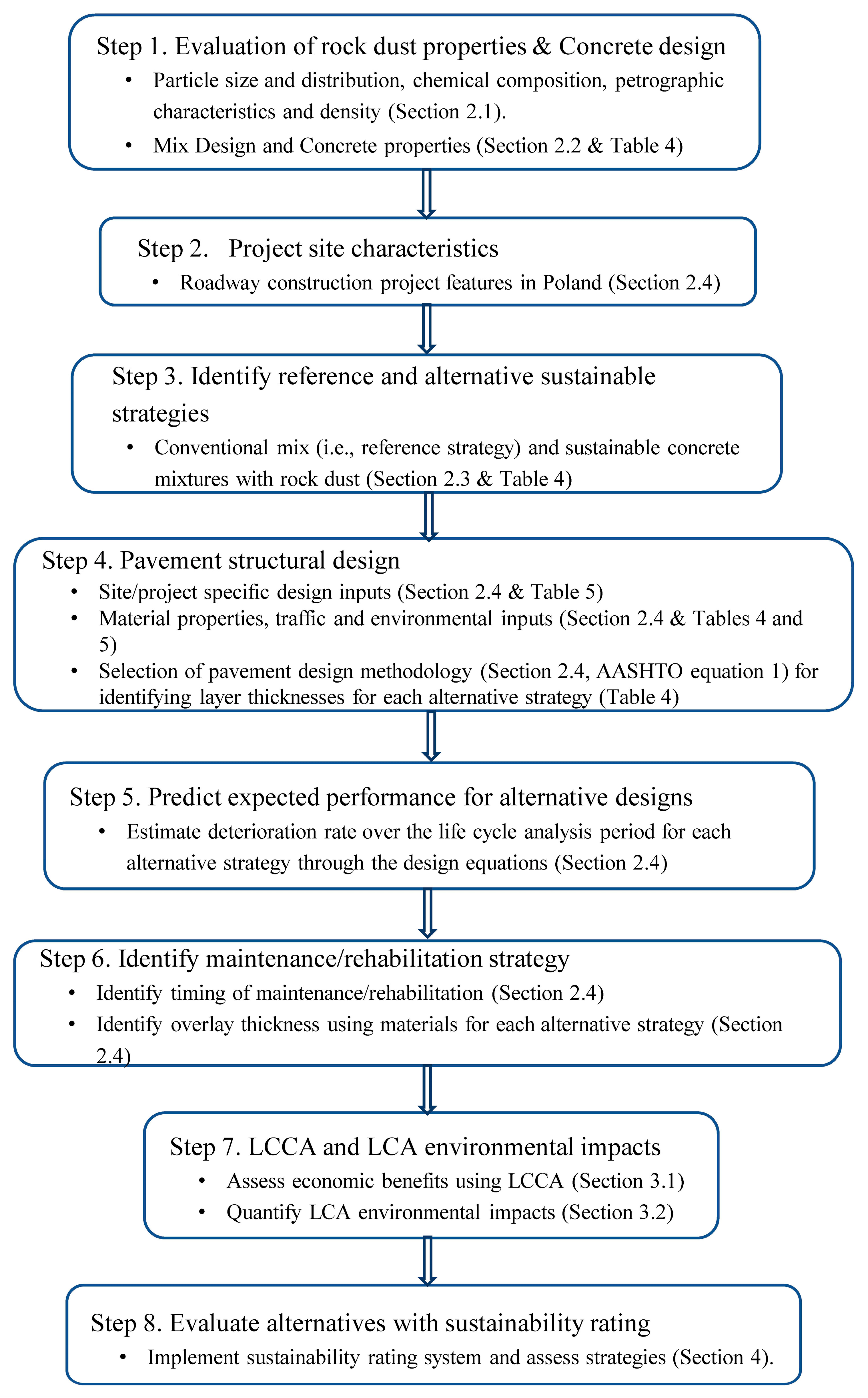
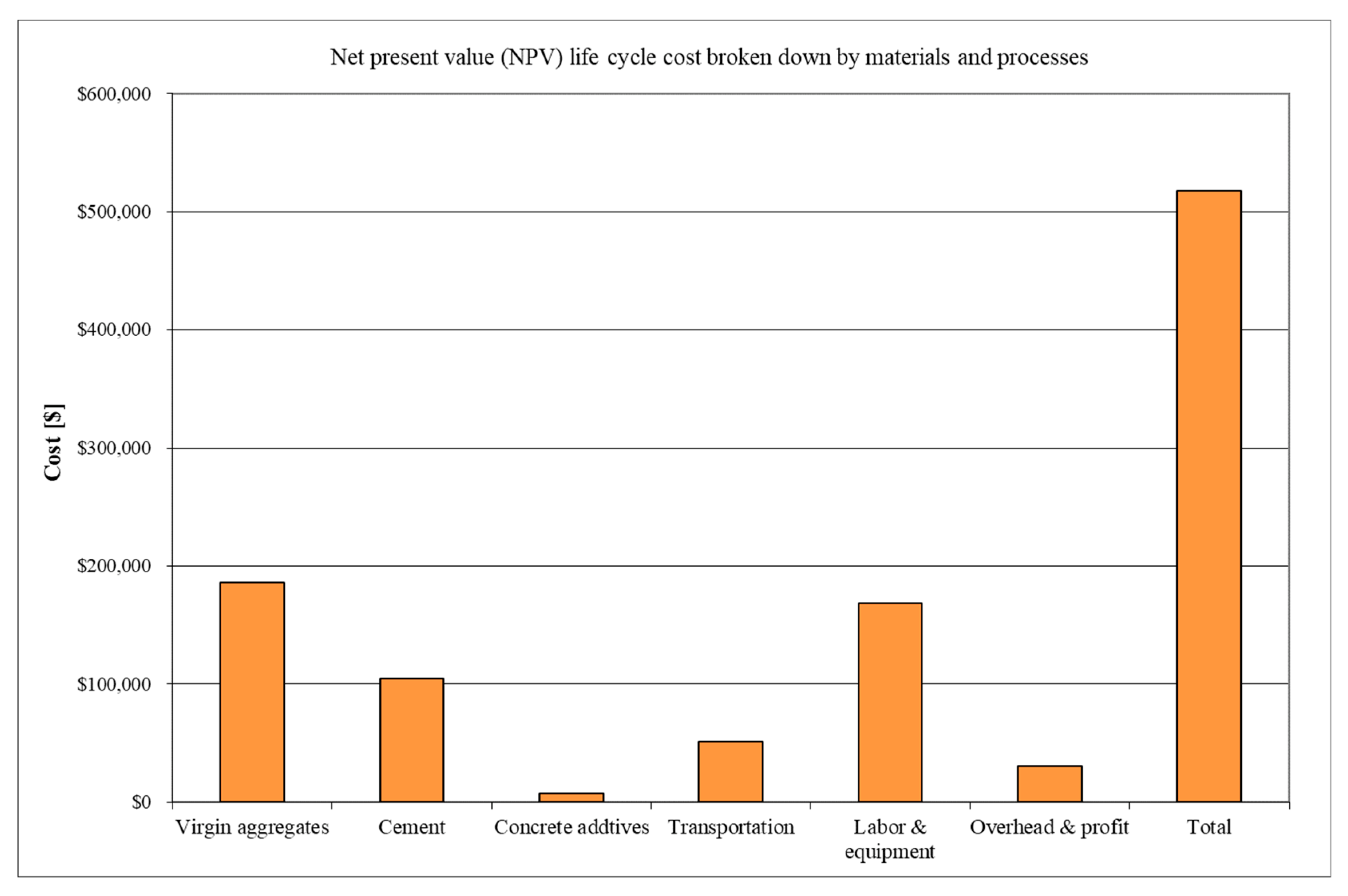
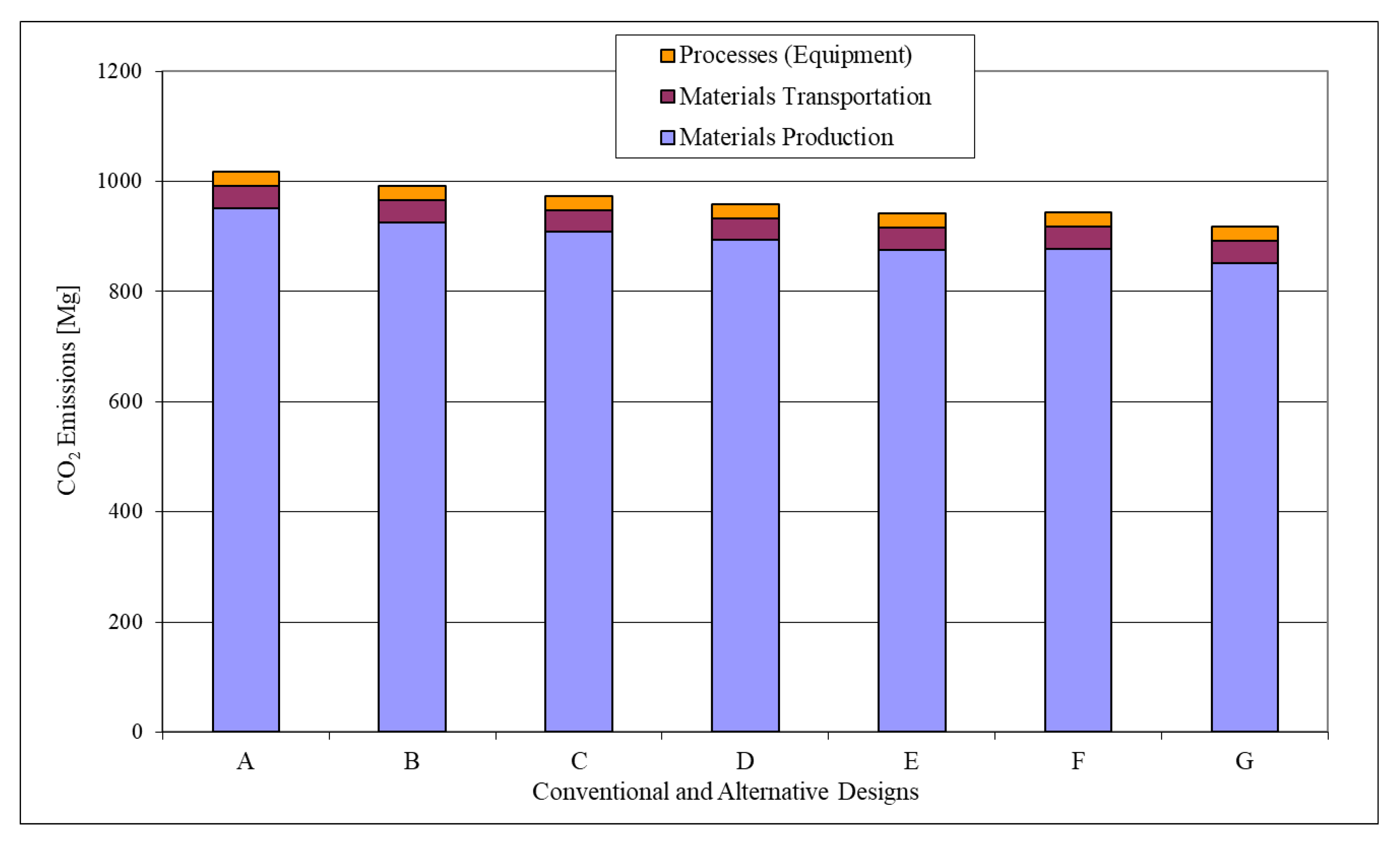
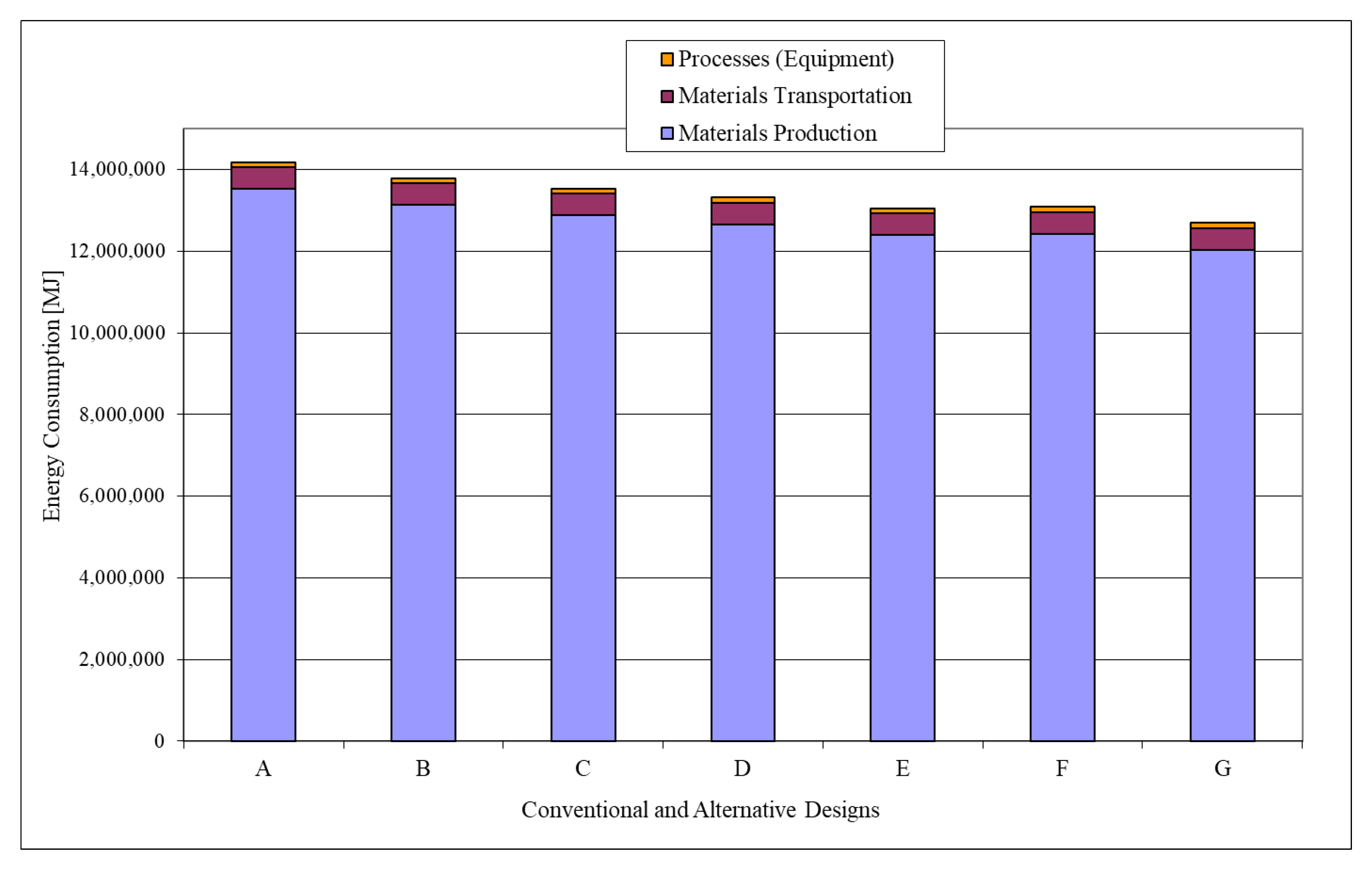
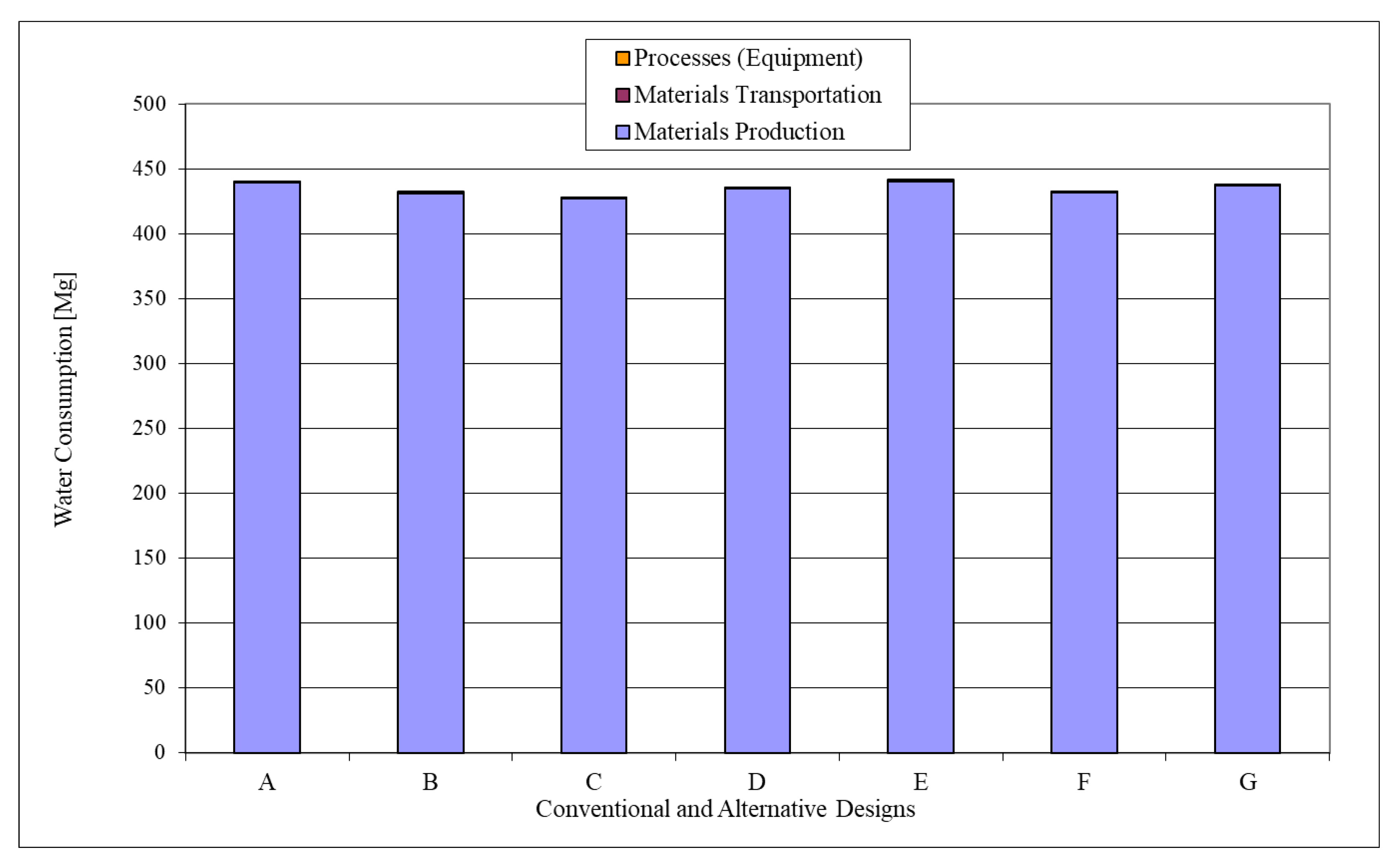

| Chemical Composition [%] | |
|---|---|
| SiO2 | 19.33 |
| Al2O3 | 5.15 |
| Fe2O3 | 2.90 |
| CaO | 64.59 |
| MgO | 1.25 |
| SO3 | 3.23 |
| K2O | 0.47 |
| Na2O | 0.21 |
| Cl− | 0.05 |
| Chemical Composition [%] | |
|---|---|
| SiO2 | 42.61 |
| Al2O3 | 12.90 |
| Fe2O3 | 14.05 |
| CaO | 13.00 |
| MgO | 7.82 |
| Na2O | 1.76 |
| K2O | 1.15 |
| P2O5 | 1.80 |
| SO3 | 0.07 |
| MnO | 0.25 |
| Cl− | 0.10 |
| Concrete | Cement (kg/m3) | Water (kg/m3) | Rock Dust (kg/m3) | Fine Aggregate (kg/m3) | Coarse Aggregate (kg/m3) |
|---|---|---|---|---|---|
| A | 350 | 155 | 0 | 533 | 1400 |
| B | 350 | 53.3 | 479.7 | ||
| C | 350 | 106.6 | 426.4 | ||
| D | 332.5 | 70.8 | 479.7 | ||
| E | 315 | 88.3 | 479.7 | ||
| F | 332.5 | 124.1 | 426.4 | ||
| G | 315 | 141.6 | 426.4 |
| Materials | Cost (USD/ton) |
|---|---|
| Sand | 6 |
| Aggregates | 26 |
| Cement | 115 |
| Concrete additives | 1918 |
| Materials and Processes | Energy [g/ton] | Water Consumption [g/ton] | CO2 [g/ton] GWP | NOx [g/ton] | PM10 [g/ton] | SO2 [g/ton] | CO [g/ton] | Hg [g/ton] | Pb [g/ton] | RCRA Hazardous Waste Generated [g/ton] |
|---|---|---|---|---|---|---|---|---|---|---|
| Aggregates | 309 | 43 | 21,884 | 44 | 189 | 21 | 29 | 0 | 0 | 359 |
| Cement | 5168 | 2561 | 362,695 | 4362 | 817 | 4324 | 1550 | 0 | 0.4 | 2240 |
| Concrete additives | 23,784 | 22,190 | 1,423,609 | 5796 | 2084 | 4285 | 7299 | 0.1 | 3 | 354,745 |
| Concrete mixing | 536 | 932 | 37,099 | 551 | 172 | 484 | 337 | 0 | 0 | 169 |
| Phases | Energy [MJ] | Water Consumption [kg] | CO2 GWP [Mg] | NOx [kg] | PM10 [kg] | SO2 [kg] | CO [kg] | Hg [g] | Pb [g] | RCRA Hazardous Waste Generated [kg] | |
|---|---|---|---|---|---|---|---|---|---|---|---|
| Material production | Aggregates | 2,692,434 | 368,398 | 200,386 | 458,881 | 1,625,638 | 189,268 | 246,631 | 0 | 56 | 3416 |
| Cement | 5,299,818 | 2,626,233 | 371,960 | 4,473,129 | 837,777 | 4,434,189 | 1,589,180 | 5 | 433 | 2298 | |
| Additives | 128,777 | 120,145 | 7708 | 31,383 | 11,286 | 23,201 | 39,522 | 0 | 18 | 1921 | |
| Concrete mixing | 4,310,516 | 1,362,680 | 298,275 | 4,431,384 | 1,383,974 | 3,887,396 | 2,706,768 | 9 | 471 | 7493 | |
| Transportation | Concrete from plant to site | 246,521 | 41,972 | 18,430 | 981,871 | 191,393 | 58,912 | 81,823 | 0 | 8 | 1776 |
| Waste materials from site to landfill/ recycling plant | 280,395 | 47,739 | 20,962 | 1,116,787 | 217,795 | 67,007 | 93,066 | 0 | 9 | 2020 | |
| Processes | Base construction | 16,796 | 1633 | 1261 | 27,248 | 4295 | 1802 | 5872 | 0 | 1 | 121 |
| PCC paving | 24,865 | 2418 | 1866 | 38,473 | 13,790 | 2544 | 8290 | 0 | 1 | 179 | |
| Strategy | NOx [kg] | PM10 [kg] | SO2 [kg] | CO [kg] | Hg [g] | Pb [g] | RCRA Hazardous Waste Generated [kg] |
|---|---|---|---|---|---|---|---|
| A | 12,368 | 4540 | 9271 | 5106 | 15 | 1096 | 24,879 |
| B | 12,124 | 4421 | 9079 | 4982 | 15 | 1063 | 23,150 |
| C | 11,996 | 4340 | 8980 | 4907 | 15 | 1041 | 21,665 |
| D | 11,801 | 4369 | 8748 | 4846 | 14 | 1017 | 21,197 |
| E | 11,671 | 4361 | 8598 | 4782 | 14 | 989 | 19,364 |
| F | 11,703 | 4298 | 8674 | 4785 | 14 | 998 | 19,761 |
| G | 11,462 | 4267 | 8417 | 4681 | 14 | 959 | 17,854 |
Publisher’s Note: MDPI stays neutral with regard to jurisdictional claims in published maps and institutional affiliations. |
© 2022 by the authors. Licensee MDPI, Basel, Switzerland. This article is an open access article distributed under the terms and conditions of the Creative Commons Attribution (CC BY) license (https://creativecommons.org/licenses/by/4.0/).
Share and Cite
Zhao, Y.; Goulias, D.; Dobiszewska, M.; Modrzyński, P. Life-Cycle Sustainability Assessment of Using Rock Dust as a Partial Replacement of Fine Aggregate and Cement in Concrete Pavements. Sustainability 2022, 14, 12449. https://doi.org/10.3390/su141912449
Zhao Y, Goulias D, Dobiszewska M, Modrzyński P. Life-Cycle Sustainability Assessment of Using Rock Dust as a Partial Replacement of Fine Aggregate and Cement in Concrete Pavements. Sustainability. 2022; 14(19):12449. https://doi.org/10.3390/su141912449
Chicago/Turabian StyleZhao, Yunpeng, Dimitrios Goulias, Magdalena Dobiszewska, and Paweł Modrzyński. 2022. "Life-Cycle Sustainability Assessment of Using Rock Dust as a Partial Replacement of Fine Aggregate and Cement in Concrete Pavements" Sustainability 14, no. 19: 12449. https://doi.org/10.3390/su141912449
APA StyleZhao, Y., Goulias, D., Dobiszewska, M., & Modrzyński, P. (2022). Life-Cycle Sustainability Assessment of Using Rock Dust as a Partial Replacement of Fine Aggregate and Cement in Concrete Pavements. Sustainability, 14(19), 12449. https://doi.org/10.3390/su141912449







